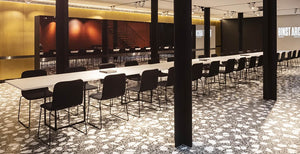Richard Hutten

Richard Hutten
Richard Hutten (1967) is known for his conceptually innovative and more importantly, sustainable design. Graduated from the Design Academy Eindhoven and started his own studio in Rotterdam. Richard developed his own subtle and sober design style. In 1992 he broke through internationally with his very functional, no-nonsense “No Sign of Design Chair” that was the first of the iconic series. Currently Richard Hutten is one of the internationally renowned leading figures in the industry. His work can be found in over 40 museums in the world, including MoMA New York, Victoria & Albert Museum London, Stedelijk Museum Amsterdam and Vitra Designmuseum, Weil am Rhein.

Loop Chair in a perforated version is also available with or without armrests.
THIS Chair family
The chair called: “This Chair” developed for Lensvelt was the first product of Lensvelts collaboration with Richard Hutten. It was such a success that many variations have then been created. It is one of the most affordable and also most comfortable chairs in Richard Hutten’s body of work. His designs for Lensvelt includes: This Chair, Bucket Chair and No Sign of Design series.
“Richard Hutten is kind of a mathematician. A designer who can deal with very complex requirements. Who is endlessly looking for the right solution and This Bucket Chair is an example.” – Hans Lensvelt
Hans Lensvelt mentioned the status Richard Hutten has cultivated in Asia and describes it as “incredible”. When Hutten lands in Tokyo, he frequently leaves people star struck. Hutten - ‘I have experienced that someone fainted because she was talking to me, yes. I was the first foreign designer to show at Tokyo Design Week in the mid-1990s. That gave me a big head start.'

Original sketch of the Loop Chair by Stefan Scholten
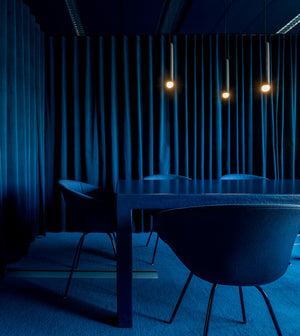
Bucket Chairs _Aidsfonds Amsterdam
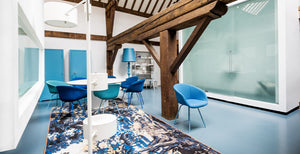
Bucket Chairs _Lensvelt Loft
Lensvelt asked Richard Hutten to design the most sustainable and comfortable bucket chair out there. The expectations were for Richard to design an aluminum mechanism that automatically adjusts to one’s body weight - a complex product. Nevertheless, Richard came up with a much more intelligent solution: an assembly by only using a fairing and a frame connected with four screws. The chair is made of the same plastic that car bumpers are made of. This allows for the Bucket Chair to remain infinitely flexible. Richard positioned the mounting points on the frame in such a way that the shell moves with your body.
Additionally, the chair is also easy to disassemble. If the tub or frame should ever break, it is easy to replace, following the sustainability aspect that Richard Hutten is so fond of. This keeps the product endlessly in the circular loop. And should the chair or frame ever become outdated, it can easily be recycled.
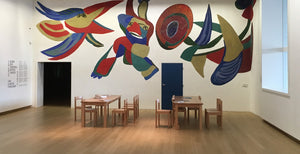
No Sign of Design _Stedelijk Museum Amsterdam
No Sign of Design
Richard Hutten's series 'No Sign of Design', that he originally created as his graduation work for the Design Academy in Eindhoven, stands for sober, no-nonsense and functionality. The "Table Chair" from 1992, now known as classic Dutch Design, was the first of the "No Sign of Design" series to attract attention. Just like Gerrit Rietveld, Hutten returns to the essence of form, breaking more decorative tendencies. The new series of tables and chairs produced by Lensvelt lies in continuity of what Hutten had created 25 years ago.
In 2016, Richard Hutten asked if Lensvelt wanted to take over the production of his No Sign of Design series of furniture. Hans Lensvelt was already a fan of this archetype design chair. He therefore considered it a great honor. And a welcome addition to the products in the collection. With great international interest, Lensvelt re-launched the No Sign of Design series in the Lensvelt gallery on the Herengracht in Amsterdam. The No Sign of Design Tables and Chairs are used for the visitors of the Stedelijk Museum, Amsterdam.

No Sign of Design collection

Launch No Sign of Design by Richard Hutten 2016
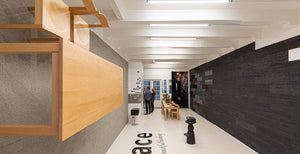
Launch No Sign of Design by Richard Hutten 2016
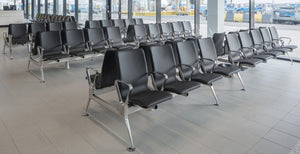
Blink_ click here for more about this plastic-free and locally-produced seating system designed for airports
Sustainability
Richard Hutten prides himself on being a green designer. On top of that he actively chooses to live in an energy-neutral home, became a vegetarian, sold his car, chooses for public transport and continuously creates sustainable products. Minimizing his carbon footprint anyway he can to contribute to a greener future. Because sustainability is part of his core philosophy of design he likes to get creative and combine traditional with industrial production processes. An example of this is the Schiphol Blink seating system.
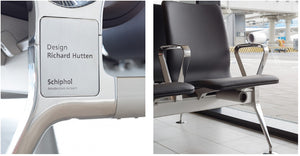
Click here_ for more about Schiphol airport Pier 24
Blink
Lensvelt and Richard Hutten worked together creating 27,000 new seats for Schiphol airport in Amsterdam. The seating system, called Blink looks like standard airport seating, with rows of ergonomically curved seats fixed to a horizontal supporting beam. However, everything about the seating system is far from standard. In order to produce Blink, the old seats at Schiphol were recycled; and the old seats became the new seats. This was done through the re-usability of products, the recycling of raw materials and using sustainable materials such as coconut fiber, wool or recycled clothing. Additionally, recyclable aluminum is used, the upholstery is designed in a way that it can be reupholstered when flawed and we make use of bio-based table tops. The composition of this material is natural-based resin that is reinforced with natural fibers. So that after a long life cycle, it can be fully reused. The carbon footprint of Blink is 95% less compared with similar products from competition. The main focus in the design was to create a product that was as long lasting as possible, however, should its lifecycle come to an end, we have ensured it can be stripped down and recycled again easily. Following a circular design philosophy all the materials that comprise the seats are either recycled, recyclable or biodegradable.
